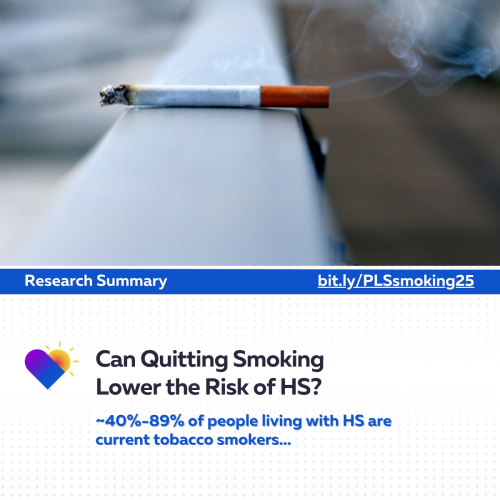
Can Quitting Smoking Lower the Risk of Hidradenitis Suppurativa?
September 29, 2025
Authors:
Safiya Haque, University of Alabama Heersink School of Medicine
Edited by:
Peter Dimitrion, Wayne State University School of Medicine
Why Was This Research Done?
It is estimated that between 40% and 89% of people living with hidradenitis suppurativa (HS) are current tobacco smokers. Smoking is known to increase the risk of developing HS. Cigarettes and other tobacco products contain nicotine and burn products like polyaromatic hydrocarbons that can both trigger and worsen inflammation that is seen in HS. This study aimed to determine if quitting smoking could help reduce the chances of developing HS.
How Was This Research Done?
Researchers studied health records from over 6 million people in South Korea. They grouped people based on their smoking habits: people who smoked throughout the study, people who previously smoked but quit, people who never smoked, and people who started smoking during the study.
They followed these groups for up to 14 years, from January 1, 2008, until they either developed HS, died, or reached the end of the study period on December 31, 2021, whichever came first. They then compared the risk of developing HS among these different groups.
What Did This Study Find?
This study showed that smoking status strongly affects the risk of HS. People who had never smoked had the lowest risk. Current smokers were nearly twice as likely as those who never smoked to develop HS. Quitting did lower the risk, but only if people remained smoke-free. Among those who quit smoking, the odds of developing HS dropped by about 33% compared to people who continued smoking. However, that benefit didn’t show up right away. The study showed it took around three years after quitting for the risk to start going down. People who relapsed had about the same risk of HS as those who never quit. Similarly, people who started smoking during the study had a similar risk of developing HS compared to long-term smokers. In summary, quitting smoking for at least three years helps reduce the chances of HS, but starting again or never quitting keeps the risk high.
What Is the Big Picture?
This study shows that quitting smoking can reduce the risk of getting HS, even for people who have smoked for a long time. The study found that about three years after quitting, the benefits are achieved. This benefit grows the longer patients remain smoke-free. It also found that restarting smoking can raise the risk of developing HS just as much as never quitting. Remaining tobacco-free is just as important as quitting in the first place.
If you are a current smoker, quitting may be one of the most powerful steps you can take for not only your skin, but your overall health as well. There are a variety of both pharmacologic and non-pharmacologic resources to aid in smoking cessation such as nicotine replacement, counseling, and support programs. Talking with a healthcare provider can help determine which options may be best for you.
Paper citation: Kim SR, Choi Y, Jo SJ. Smoking Cessation and Risk of Hidradenitis Suppurativa Development. JAMA Dermatol. 2024;160(10):1056–1065.
Image Credit: unsplash.com

